Cost Accounting Memo: Analyzing Problems and Recommending Improvements
VerifiedAdded on 2023/03/20
|5
|1376
|23
Report
AI Summary
This cost accounting memo analyzes the standard costing system used by Cabinet Inc., a company providing kitchen solutions. It identifies drawbacks such as the unsuitability of standard costs for urgent orders, leading to unfavorable labor variances due to overtime. The memo highlights problems with materiality limits, non-reporting of variances, and the impact on employee morale. Recommendations are provided to improve the system, including correcting complexity, ensuring scalability, and involving employees. The analysis underscores the importance of cost accounting and suggests changes to reduce variances and balance the firm's operations. The memo emphasizes the need for a flexible and employee-inclusive approach to cost accounting to ensure accurate performance evaluation and maintain employee morale.
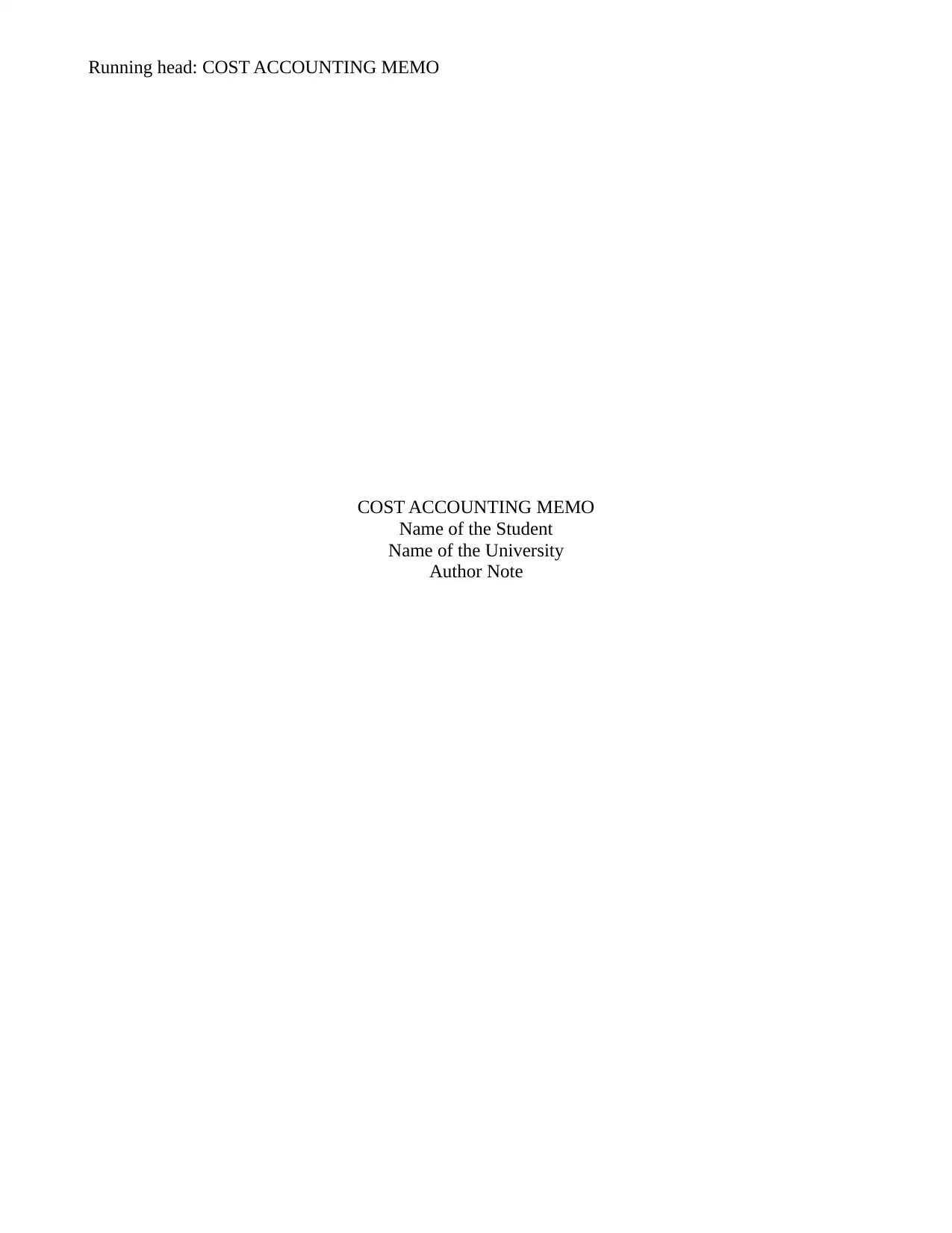
Running head: COST ACCOUNTING MEMO
COST ACCOUNTING MEMO
Name of the Student
Name of the University
Author Note
COST ACCOUNTING MEMO
Name of the Student
Name of the University
Author Note
Paraphrase This Document
Need a fresh take? Get an instant paraphrase of this document with our AI Paraphraser
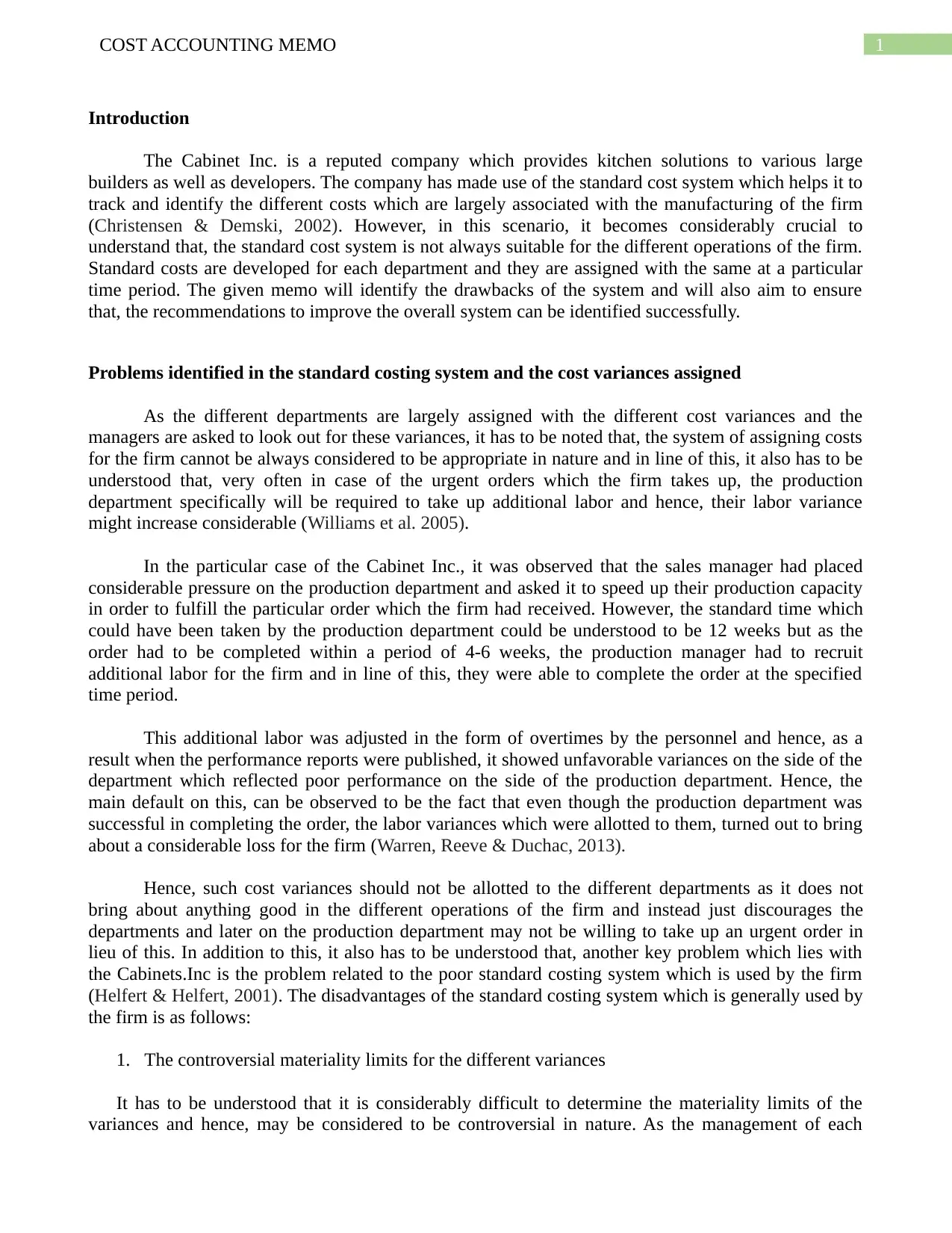
1COST ACCOUNTING MEMO
Introduction
The Cabinet Inc. is a reputed company which provides kitchen solutions to various large
builders as well as developers. The company has made use of the standard cost system which helps it to
track and identify the different costs which are largely associated with the manufacturing of the firm
(Christensen & Demski, 2002). However, in this scenario, it becomes considerably crucial to
understand that, the standard cost system is not always suitable for the different operations of the firm.
Standard costs are developed for each department and they are assigned with the same at a particular
time period. The given memo will identify the drawbacks of the system and will also aim to ensure
that, the recommendations to improve the overall system can be identified successfully.
Problems identified in the standard costing system and the cost variances assigned
As the different departments are largely assigned with the different cost variances and the
managers are asked to look out for these variances, it has to be noted that, the system of assigning costs
for the firm cannot be always considered to be appropriate in nature and in line of this, it also has to be
understood that, very often in case of the urgent orders which the firm takes up, the production
department specifically will be required to take up additional labor and hence, their labor variance
might increase considerable (Williams et al. 2005).
In the particular case of the Cabinet Inc., it was observed that the sales manager had placed
considerable pressure on the production department and asked it to speed up their production capacity
in order to fulfill the particular order which the firm had received. However, the standard time which
could have been taken by the production department could be understood to be 12 weeks but as the
order had to be completed within a period of 4-6 weeks, the production manager had to recruit
additional labor for the firm and in line of this, they were able to complete the order at the specified
time period.
This additional labor was adjusted in the form of overtimes by the personnel and hence, as a
result when the performance reports were published, it showed unfavorable variances on the side of the
department which reflected poor performance on the side of the production department. Hence, the
main default on this, can be observed to be the fact that even though the production department was
successful in completing the order, the labor variances which were allotted to them, turned out to bring
about a considerable loss for the firm (Warren, Reeve & Duchac, 2013).
Hence, such cost variances should not be allotted to the different departments as it does not
bring about anything good in the different operations of the firm and instead just discourages the
departments and later on the production department may not be willing to take up an urgent order in
lieu of this. In addition to this, it also has to be understood that, another key problem which lies with
the Cabinets.Inc is the problem related to the poor standard costing system which is used by the firm
(Helfert & Helfert, 2001). The disadvantages of the standard costing system which is generally used by
the firm is as follows:
1. The controversial materiality limits for the different variances
It has to be understood that it is considerably difficult to determine the materiality limits of the
variances and hence, may be considered to be controversial in nature. As the management of each
Introduction
The Cabinet Inc. is a reputed company which provides kitchen solutions to various large
builders as well as developers. The company has made use of the standard cost system which helps it to
track and identify the different costs which are largely associated with the manufacturing of the firm
(Christensen & Demski, 2002). However, in this scenario, it becomes considerably crucial to
understand that, the standard cost system is not always suitable for the different operations of the firm.
Standard costs are developed for each department and they are assigned with the same at a particular
time period. The given memo will identify the drawbacks of the system and will also aim to ensure
that, the recommendations to improve the overall system can be identified successfully.
Problems identified in the standard costing system and the cost variances assigned
As the different departments are largely assigned with the different cost variances and the
managers are asked to look out for these variances, it has to be noted that, the system of assigning costs
for the firm cannot be always considered to be appropriate in nature and in line of this, it also has to be
understood that, very often in case of the urgent orders which the firm takes up, the production
department specifically will be required to take up additional labor and hence, their labor variance
might increase considerable (Williams et al. 2005).
In the particular case of the Cabinet Inc., it was observed that the sales manager had placed
considerable pressure on the production department and asked it to speed up their production capacity
in order to fulfill the particular order which the firm had received. However, the standard time which
could have been taken by the production department could be understood to be 12 weeks but as the
order had to be completed within a period of 4-6 weeks, the production manager had to recruit
additional labor for the firm and in line of this, they were able to complete the order at the specified
time period.
This additional labor was adjusted in the form of overtimes by the personnel and hence, as a
result when the performance reports were published, it showed unfavorable variances on the side of the
department which reflected poor performance on the side of the production department. Hence, the
main default on this, can be observed to be the fact that even though the production department was
successful in completing the order, the labor variances which were allotted to them, turned out to bring
about a considerable loss for the firm (Warren, Reeve & Duchac, 2013).
Hence, such cost variances should not be allotted to the different departments as it does not
bring about anything good in the different operations of the firm and instead just discourages the
departments and later on the production department may not be willing to take up an urgent order in
lieu of this. In addition to this, it also has to be understood that, another key problem which lies with
the Cabinets.Inc is the problem related to the poor standard costing system which is used by the firm
(Helfert & Helfert, 2001). The disadvantages of the standard costing system which is generally used by
the firm is as follows:
1. The controversial materiality limits for the different variances
It has to be understood that it is considerably difficult to determine the materiality limits of the
variances and hence, may be considered to be controversial in nature. As the management of each
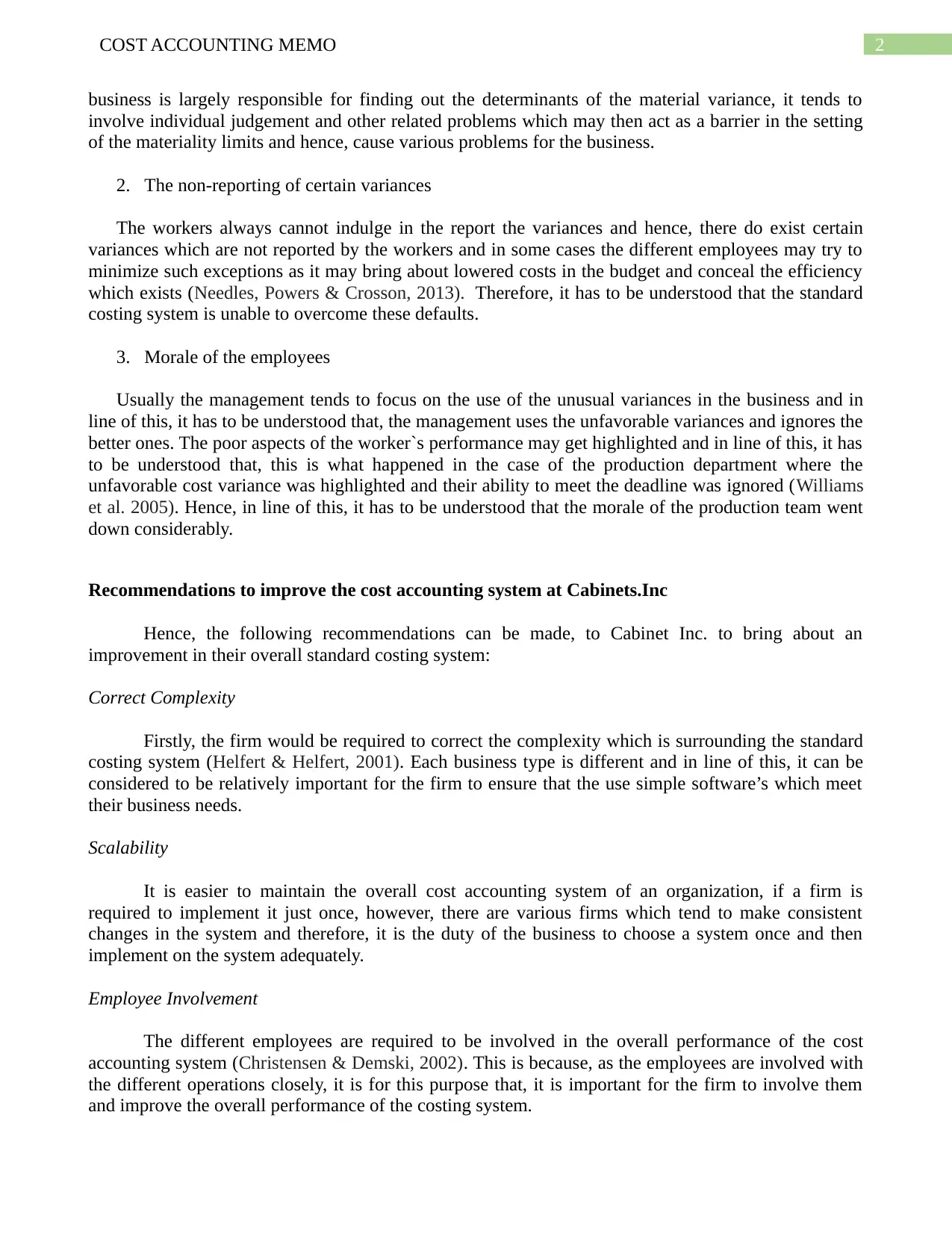
2COST ACCOUNTING MEMO
business is largely responsible for finding out the determinants of the material variance, it tends to
involve individual judgement and other related problems which may then act as a barrier in the setting
of the materiality limits and hence, cause various problems for the business.
2. The non-reporting of certain variances
The workers always cannot indulge in the report the variances and hence, there do exist certain
variances which are not reported by the workers and in some cases the different employees may try to
minimize such exceptions as it may bring about lowered costs in the budget and conceal the efficiency
which exists (Needles, Powers & Crosson, 2013). Therefore, it has to be understood that the standard
costing system is unable to overcome these defaults.
3. Morale of the employees
Usually the management tends to focus on the use of the unusual variances in the business and in
line of this, it has to be understood that, the management uses the unfavorable variances and ignores the
better ones. The poor aspects of the worker`s performance may get highlighted and in line of this, it has
to be understood that, this is what happened in the case of the production department where the
unfavorable cost variance was highlighted and their ability to meet the deadline was ignored (Williams
et al. 2005). Hence, in line of this, it has to be understood that the morale of the production team went
down considerably.
Recommendations to improve the cost accounting system at Cabinets.Inc
Hence, the following recommendations can be made, to Cabinet Inc. to bring about an
improvement in their overall standard costing system:
Correct Complexity
Firstly, the firm would be required to correct the complexity which is surrounding the standard
costing system (Helfert & Helfert, 2001). Each business type is different and in line of this, it can be
considered to be relatively important for the firm to ensure that the use simple software’s which meet
their business needs.
Scalability
It is easier to maintain the overall cost accounting system of an organization, if a firm is
required to implement it just once, however, there are various firms which tend to make consistent
changes in the system and therefore, it is the duty of the business to choose a system once and then
implement on the system adequately.
Employee Involvement
The different employees are required to be involved in the overall performance of the cost
accounting system (Christensen & Demski, 2002). This is because, as the employees are involved with
the different operations closely, it is for this purpose that, it is important for the firm to involve them
and improve the overall performance of the costing system.
business is largely responsible for finding out the determinants of the material variance, it tends to
involve individual judgement and other related problems which may then act as a barrier in the setting
of the materiality limits and hence, cause various problems for the business.
2. The non-reporting of certain variances
The workers always cannot indulge in the report the variances and hence, there do exist certain
variances which are not reported by the workers and in some cases the different employees may try to
minimize such exceptions as it may bring about lowered costs in the budget and conceal the efficiency
which exists (Needles, Powers & Crosson, 2013). Therefore, it has to be understood that the standard
costing system is unable to overcome these defaults.
3. Morale of the employees
Usually the management tends to focus on the use of the unusual variances in the business and in
line of this, it has to be understood that, the management uses the unfavorable variances and ignores the
better ones. The poor aspects of the worker`s performance may get highlighted and in line of this, it has
to be understood that, this is what happened in the case of the production department where the
unfavorable cost variance was highlighted and their ability to meet the deadline was ignored (Williams
et al. 2005). Hence, in line of this, it has to be understood that the morale of the production team went
down considerably.
Recommendations to improve the cost accounting system at Cabinets.Inc
Hence, the following recommendations can be made, to Cabinet Inc. to bring about an
improvement in their overall standard costing system:
Correct Complexity
Firstly, the firm would be required to correct the complexity which is surrounding the standard
costing system (Helfert & Helfert, 2001). Each business type is different and in line of this, it can be
considered to be relatively important for the firm to ensure that the use simple software’s which meet
their business needs.
Scalability
It is easier to maintain the overall cost accounting system of an organization, if a firm is
required to implement it just once, however, there are various firms which tend to make consistent
changes in the system and therefore, it is the duty of the business to choose a system once and then
implement on the system adequately.
Employee Involvement
The different employees are required to be involved in the overall performance of the cost
accounting system (Christensen & Demski, 2002). This is because, as the employees are involved with
the different operations closely, it is for this purpose that, it is important for the firm to involve them
and improve the overall performance of the costing system.
⊘ This is a preview!⊘
Do you want full access?
Subscribe today to unlock all pages.

Trusted by 1+ million students worldwide
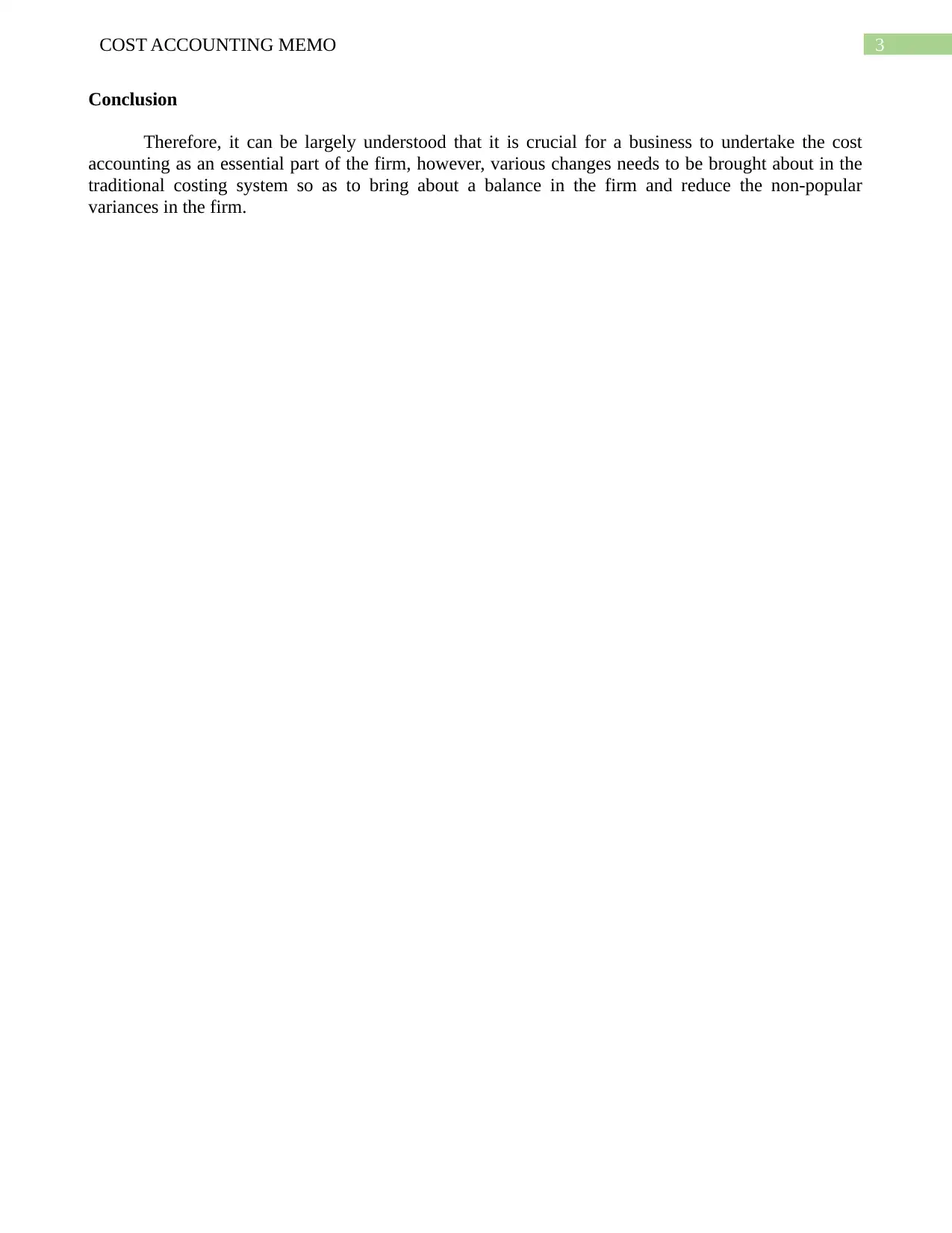
3COST ACCOUNTING MEMO
Conclusion
Therefore, it can be largely understood that it is crucial for a business to undertake the cost
accounting as an essential part of the firm, however, various changes needs to be brought about in the
traditional costing system so as to bring about a balance in the firm and reduce the non-popular
variances in the firm.
Conclusion
Therefore, it can be largely understood that it is crucial for a business to undertake the cost
accounting as an essential part of the firm, however, various changes needs to be brought about in the
traditional costing system so as to bring about a balance in the firm and reduce the non-popular
variances in the firm.
Paraphrase This Document
Need a fresh take? Get an instant paraphrase of this document with our AI Paraphraser
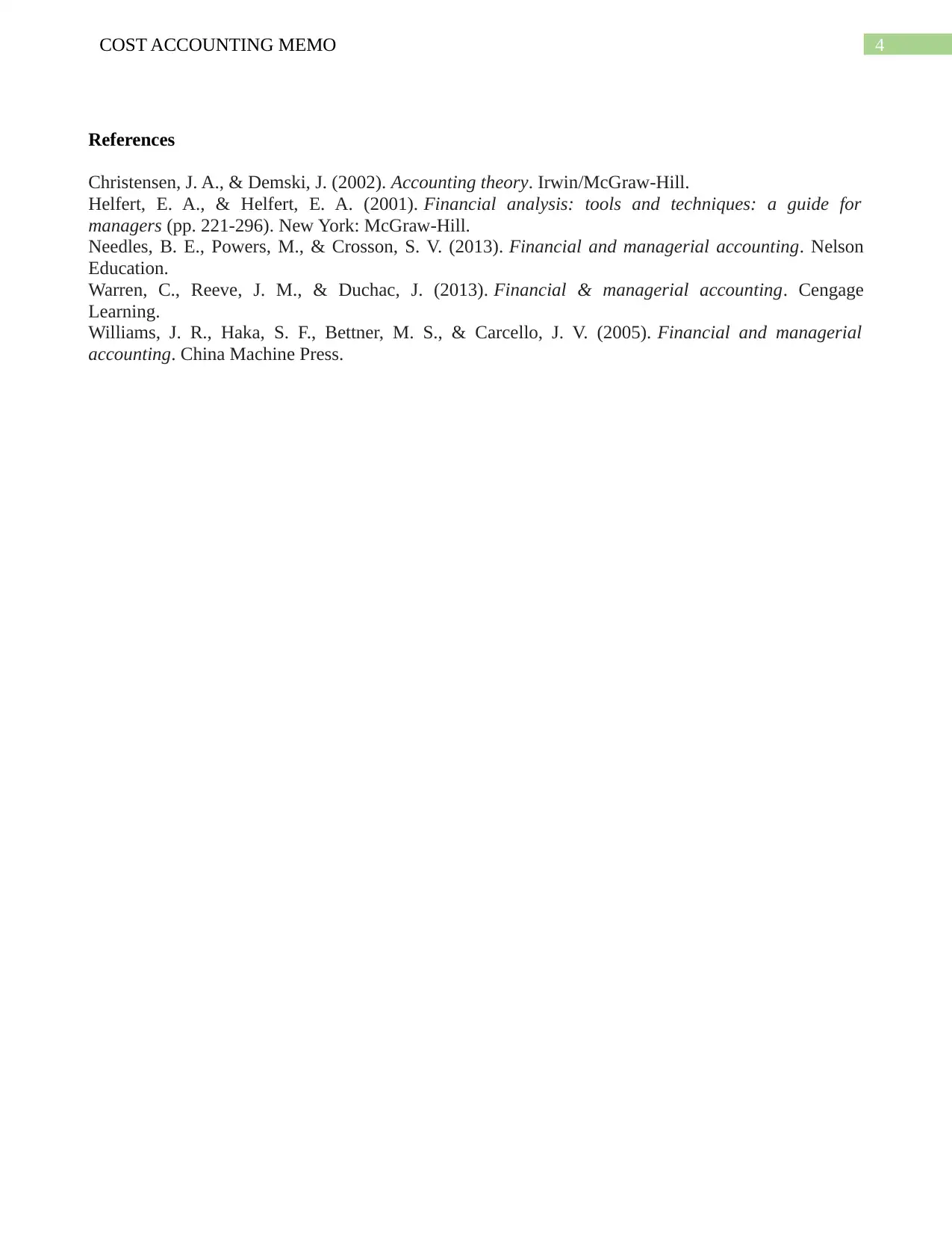
4COST ACCOUNTING MEMO
References
Christensen, J. A., & Demski, J. (2002). Accounting theory. Irwin/McGraw-Hill.
Helfert, E. A., & Helfert, E. A. (2001). Financial analysis: tools and techniques: a guide for
managers (pp. 221-296). New York: McGraw-Hill.
Needles, B. E., Powers, M., & Crosson, S. V. (2013). Financial and managerial accounting. Nelson
Education.
Warren, C., Reeve, J. M., & Duchac, J. (2013). Financial & managerial accounting. Cengage
Learning.
Williams, J. R., Haka, S. F., Bettner, M. S., & Carcello, J. V. (2005). Financial and managerial
accounting. China Machine Press.
References
Christensen, J. A., & Demski, J. (2002). Accounting theory. Irwin/McGraw-Hill.
Helfert, E. A., & Helfert, E. A. (2001). Financial analysis: tools and techniques: a guide for
managers (pp. 221-296). New York: McGraw-Hill.
Needles, B. E., Powers, M., & Crosson, S. V. (2013). Financial and managerial accounting. Nelson
Education.
Warren, C., Reeve, J. M., & Duchac, J. (2013). Financial & managerial accounting. Cengage
Learning.
Williams, J. R., Haka, S. F., Bettner, M. S., & Carcello, J. V. (2005). Financial and managerial
accounting. China Machine Press.
1 out of 5
Related Documents
Your All-in-One AI-Powered Toolkit for Academic Success.
+13062052269
info@desklib.com
Available 24*7 on WhatsApp / Email
![[object Object]](/_next/static/media/star-bottom.7253800d.svg)
Unlock your academic potential
Copyright © 2020–2025 A2Z Services. All Rights Reserved. Developed and managed by ZUCOL.





